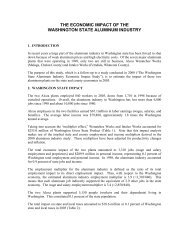WORLD POPULATION TO 2300
WORLD POPULATION TO 2300
WORLD POPULATION TO 2300
Create successful ePaper yourself
Turn your PDF publications into a flip-book with our unique Google optimized e-Paper software.
may be ascribed to HIV/AIDS. The projections<br />
assume that HIV transmission slows, so the<br />
weight of “extra” AIDS mortality is gradually<br />
lifted, but not before adding millions of deaths<br />
and dragging life expectancy down close to 40<br />
years (figure 26). Only Northern Africa is spared<br />
from this effect, which is greatest at the opposite<br />
end of the continent, in Southern Africa. Note<br />
again that both the projected declines in life expectancy<br />
and the pre-2000 declines are derived<br />
from epidemic models. The HIV/AIDS epidemic<br />
does not entirely account for slower growth in<br />
Southern Africa. Substantial fertility decline, earlier<br />
than in Eastern, Middle and Western Africa<br />
and ahead even of Northern Africa, also plays a<br />
part (figure 25).<br />
F. ASIA<br />
Asia is four-and-a-half times as populous as Africa,<br />
but by 2050 it will be less than three times as<br />
populous. By 2100, it will be 2.2 times as populous,<br />
essentially the ratio that will hold till <strong>2300</strong>.<br />
China and India make up 62 per cent of the major<br />
area and therefore are important to distinguish<br />
Life expectancy at birth<br />
95<br />
85<br />
75<br />
65<br />
55<br />
45<br />
Figure 26. Life expectancy at birth, African regions: 1950-<strong>2300</strong><br />
(figure 27). Up to 2050, China’s share of the regional<br />
population will diminish, though in absolute<br />
terms its population will still grow slightly,<br />
by 9 per cent over 50 years. India’s population, in<br />
contrast, will increase in absolute terms by 51 per<br />
cent, slightly faster than the rest of the major area.<br />
Up to 2050, still faster growth—though short of<br />
rates in several African regions—will take place<br />
in the remainder of South-central Asia and in<br />
Western Asia. Much slower growth will take<br />
place in Eastern Asia (which includes, besides<br />
China, the Koreas and Japan). Figure 28 suggests,<br />
for 2000-2050, an upward gradient in growth rates<br />
from east to west and roughly parallel declines in<br />
growth. Eastern Asia outside China slips into<br />
negative growth around 2015 and China around<br />
2030, while the other regions maintain positive<br />
growth past 2050.<br />
Beyond 2050, growth rates converge, and cross<br />
over in the decades around 2100. As often seen in<br />
these projections, the slowest growing become the<br />
fastest growing and vice versa, until the regions<br />
converge again close to zero growth. By 2100,<br />
India will have 1.46 billion people, or 29 per cent<br />
Northern Africa<br />
Western Africa<br />
Middle Africa<br />
Eastern Africa<br />
Southern Africa<br />
35<br />
1950 2000 2050 2100 2150 2200 2250 <strong>2300</strong><br />
United Nations Department of Economic and Social Affairs/Population Division 31<br />
World Population to <strong>2300</strong>





